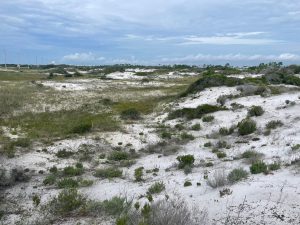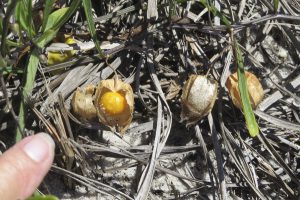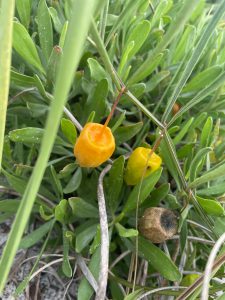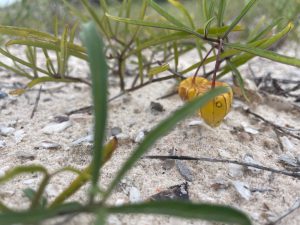
Back in the day, pirates would scour the beaches for hidden treasure. On a recent trip out with a group of botanists and biologists, we combed the dunes of Perdido Key for a specific plant that hosts a rare bee species. While not gold doubloons, they do have golden petals and can be quite hard to find!

During our search, we came across another interesting golden treasure—the seedpods of a low-growing plant called coastal groundcherry (Physalis angustifolia). The groundcherry has tough, elongated, folded leaves and produces a seed pod (called a calyx) that looks much like a Chinese paper lantern. Inside the pod is a small yellow-orange fruit, which is about the size and shape of a small cherry. Groundcherries, also called cape gooseberries, are in the genus Physalis and are related to tomatillos. I have never tasted one, but those who have describe it as “sweet, tart, and vaguely tropical” with hints of strawberry, grape, and pineapple. The fruit is full of vitamins A and C, and recipes using the fruit range from desserts to savory dishes. Beware, however; groundcherry leaves and unripened fruit are toxic, so never eat one without confirmation that the fruit is completely ripened.

Beach mice are big fans of groundcherries. Growing low to the ground in sandy dunes and coastal scrubland, the plant is easily accessible for the small mammals. Groundcherry is relatively common on the northwest coast of Florida and all the way over to Louisiana. It grows by underground stolons and thick, tuberous roots, allowing for survival in the harsh and dry dune systems. After the fruit drops out, the seedpods dry up to a brownish skeleton of their former shape, hanging from the stem until the thin skin disintegrates.

Like most native plants, the groundcherry was used by native tribes for medicinal purposes. Traditional uses ranged from treatment of eye infections and stomach problems to open wounds. Modern studies have shown many species of Physalis can fend off parasites and inhibit tumors. Extracts from the plant also exhibit antibacterial properties, including resistance to tuberculosis infections. There are many reasons to protect native habitats, but the sheer number of scientific and medical discoveries hiding among our plant communities is surely one of the most critical.



